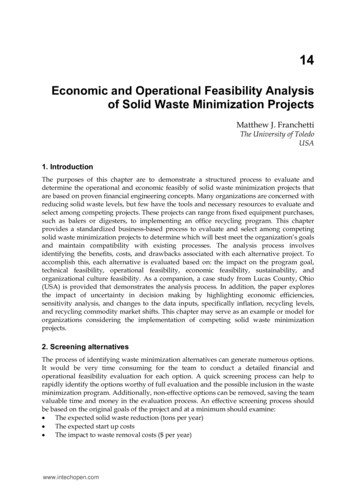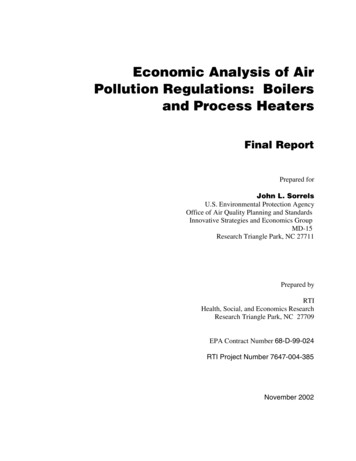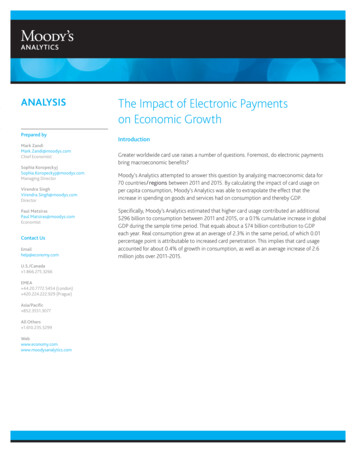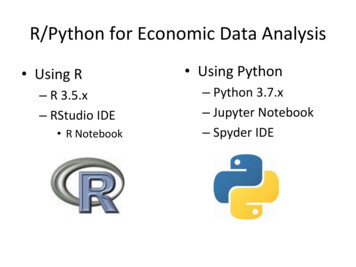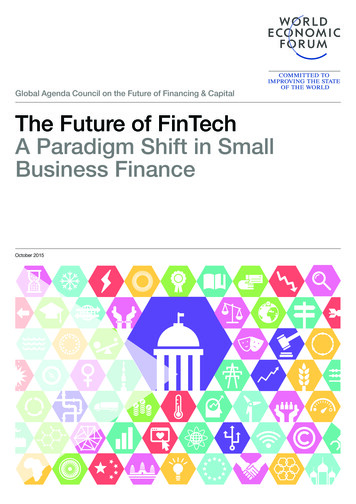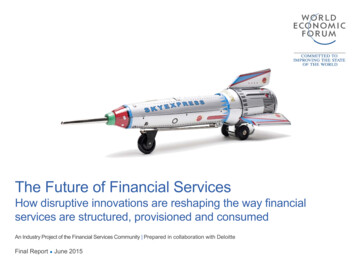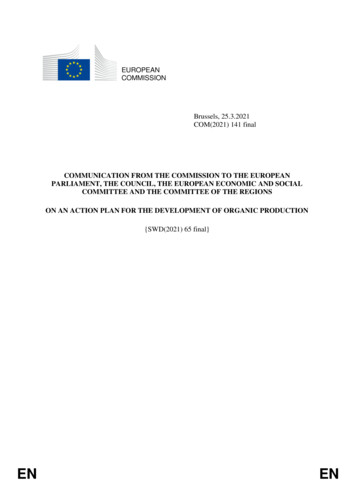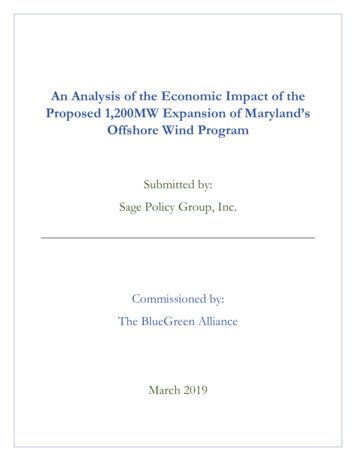
Transcription
An Analysis of the Economic Impact of theProposed 1,200MW Expansion of Maryland’sOffshore Wind ProgramSubmitted by:Sage Policy Group, Inc.Commissioned by:The BlueGreen AllianceMarch 2019
Table of ContentsExecutive Summary . 3I.Introduction . 4The BlueGreen Alliance . 4Background: Offshore Wind Energy Act of 2013 . 4Background: Clean Energy Jobs Act of 2019. 5Background: Initial Projects . 5II. Methods and How to Interpret Results . 6III. Additional 1,200 MW of Capacity . 8Construction Impacts . 9Operational Impacts .11Conclusion .13Appendix I: Economic & Fiscal Impacts of the Initially Approved 368 MW of Capacity .14Construction Impacts .15Operational Impacts .17Appendix II: List of Conditions Required for Approval of Qualified Offshore Wind Projects .18List of ExhibitsExhibit 1: Estimated In-state Capital Expenditures, 2026, 2028, and 2030. 9Exhibit 2: Construction Phase Economic Impacts, Additional 1,200 MW of Capacity .10Exhibit 3: Construction Phase Fiscal Impacts (Millions 2019), Additional 1,200 MW of Capacity 10Exhibit 4: Jobs per MW of Capacity, Construction Phase .11Exhibit 5: Operating Economic Impacts, Initial 368 MW Additional 1,200 MW of Capacity .12Exhibit 6: Operational Fiscal Impacts, Initial 368 MW Additional 1,200 MW Capacity.12Exhibit A1: Development Phases Modeled in this Report, Initial 368 MWs .14Exhibit A2: Economic Impacts from Construction of Initial two OSW Farms.15Exhibit A3: Economic Impacts from Construction of OSW Farms, Port Upgrades, and SteelFabrication Plant (one-time only) .16Exhibit A4: Construction Phase Fiscal Impacts, Initial 368 MW of Capacity .16Exhibit A5: Operational Economic Impacts, Initial 368 MW of Capacity .17Exhibit A6: Operational Phase Fiscal Impacts, Initial 368 MW of Capacity .17An Analysis of the Economic Impact of the Proposed 1,200MW Expansion of Maryland’s Offshore Wind Program2
An Analysis of the Economic Impact of the Proposed 1,200MW Expansion ofMaryland’s Offshore Wind ProgramExecutive SummaryThe BlueGreen Alliance commissioned Sage Policy Group, Inc. (Sage) to assess the economic and fiscalimpacts of a prospective 1,200 MW expansion of Maryland’s offshore wind (OSW) capacity as established inthe proposed Clean Energy Jobs Act (“CEJA”). Sage began its analysis by evaluating two OSW projectspreviously approved by the Maryland Public Service Commission (MD PSC). These two projects will jointlygenerate 368 MWs of renewable energy generation capacity in Maryland.Together with the capacity authorized under CEJA, Maryland will ultimately be home to 1,568 MWs ofoffshore wind capacity if requisite approvals are garnered. This study provides economic and fiscal impactestimates associated with the construction and operational phases of OSW developments in Maryland;developments that have the potential to position the Free State at the forefront of renewable energy in thenation’s Mid-Atlantic region.Key Analytical Findings Construction associated with the provision of 1,200 MW of OSW capacity in Maryland as authorizedby the CEJA will support an estimated 25,000 jobs (where a job is defined as one position lasting forone year), 1.5 billion in associated labor and proprietor income, and 3.6 billion in augmentedeconomic activity; Once construction of the additional 1,200 MW of OSW capacity authorized by the CEJA iscomplete, operation and maintenance of the facilities will support approximately 1,500 jobs and morethan 100 million in labor income per annum; Once the 1,200 MWs are online, State tax revenues will be augmented by nearly 23 million perannum. Local tax revenues throughout Maryland will be bolstered by nearly 13 million per annum; Jobs supported by these projects are associated with skilled positions in manufacturing, construction,installation, operations, and maintenance. Accordingly, average annual income per workerapproaches 60,000 during construction and 70,000 during operations; Capital expenditure-related benefits of this additional 1,200 MW are additive to those supported bythe two initial OSW developments (368 MW) already approved by the MD PSC:oConstruction of the initial 368 MW will support approximately 7,100 jobs, 421.7 million inassociated labor income, and almost 1 billion in augmented economic activity statewide;oConstruction of these initial two OSW facilities will augment State tax revenues byapproximately 23 million and local tax revenues by approximately 15 million;oOnce operational, the initial two OSW facilities will support nearly 360 ongoing annual jobsassociated with 25 million in income per annum.An Analysis of the Economic Impact of the Proposed 1,200MW Expansion of Maryland’s Offshore Wind Program3
I. IntroductionThe BlueGreen Alliance commissioned Sage Policy Group, Inc. (Sage) to assess the prospectiveeconomic and fiscal impacts of the 1,200 MW proposed expansion of Maryland’s offshore wind(OSW) procurement as established in the proposed Clean Energy Jobs Act (CEJA). Impactsassociated with the 1,200 MW expansion will be additive to the economic and fiscal impactsassociated with an initial 368 MW of OSW capacity supply in Maryland.1The BlueGreen AllianceThe BlueGreen Alliance links America’s largest labor unions and its most influential environmentalorganizations to help solve today’s environmental challenges in ways that create and maintain qualityjobs and build a stronger, fairer economy. The organization is guided by the principle that thereshould be simultaneous commitment to good jobs and a clean environment rather than perceivedtradeoffs between the two. The current period represents a time of enormous promise from theperspective of the BlueGreen Alliance. Offshore wind produces clean, renewable energy whilecreating quality jobs that rely heavily on advanced manufacturing in supply chain and skilled laborfor construction, installation, operations, and maintenance. Offshore wind development is occurringalong much of the East Coast, including in Connecticut, Massachusetts, Virginia, Rhode Island, NewYork, New Jersey, and Maryland.Background: Offshore Wind Energy Act of 2013In 2013, the Maryland legislature enacted the Maryland Offshore Wind Energy Act of 2013(OWEA), which positioned Maryland to emerge as the first U.S. state with a ready market for powergenerated via OSW. The OWEA established Offshore Wind Renewable Energy Credits (ORECs)as a mechanism to incentivize development of OSW projects. OWEA also supplies 10 million toMaryland’s small businesses to ensure that they are prepared to participate in OSW’s supply chain,which is vast, complex, and expanding rapidly across the globe.Among other things, OWEA: 1) requires that electricity suppliers purchase ORECs; 2) creates acarve-out for offshore wind energy of up to 2.5 percent of total retail electricity sales in Maryland;and 3) implements the following pricing limitations:Regarding offshore wind turbines, in a July 2017 Sage report based on a literature review of global breadth, we concluded that there is “Littleevidence of negative impact on property values, though there is also scant evidence of positive impacts.” We further concluded that, “The majority ofvisitor survey-based studies of wind farm impacts have found that they have little to no impact on tourism or that the impact had been too small to bediscernible.” Accordingly, we have not seen fit to address the potential impact of wind turbines on tourism in this report.1An Analysis of the Economic Impact of the Proposed 1,200MW Expansion of Maryland’s Offshore Wind Program4
1. Projected net rate impacts for residential electricity customers cannot not exceed 1.50 permonth in 2012 dollars ( 1.67 in 2019 dollars);2. Projected net rate impacts for all nonresidential customers cannot exceed 1.5 percent ofnonresidential customers’ total annual electric bills; and3. The price of electricity cannot exceed 131/Megawatt hour (MWh) in 2012 dollars (about 146 in 2019 dollars).Passage of the law triggered a process by which Maryland would be positioned to comply.Compliance requires the provision of new sources of OSW electricity generation.Background: Clean Energy Jobs Act of 2019The Clean Energy Jobs Act of 2019 increases the State’s Renewable Energy Portfolio Standard(RPS) from 25 percent by 2020 to 50 percent by 2030 and, among other things, expands the State’soffshore wind program by 1,200 MW with three new application periods. If approved, the billwould require the MD PSC to open application windows for at least 400 MW to come online by2026, an additional 400 MW by 2028, and yet another 400 MW by 2030. It is certainly possible thatthese 1,200 MW would come online prior to 2030, which means that associated economic and fiscalimpacts would be realized sooner. This additional 1,200 MW of capacity would increase the State’stotal OSW capacity to 1,568 MW.Background: Initial ProjectsBased on the authority granted it under OWEA, on May 11th, 2017, the Maryland Public ServiceCommission (PSC) awarded orders for two separate projects to be developed by U.S. Wind, Inc. andSkipjack Offshore Energy, LLC, respectively. Those two distinct developments, which represent thenation’s first large-scale OSW projects, will jointly support 368 megawatts (MW) of OSW capacityonce operational.Per requirements set forth in PSC orders, both projects are subject to approximately 30 conditions,many of which pertain to economic benefits ultimately to inure to Marylanders. For instance, OSWdevelopers are required to use specific ports in the Baltimore and Ocean City regions, create aspecified minimum number of jobs, invest in local steel fabrication plants, and fund certain upgradesat regional ports.In part to reduce any threat to tourism activities and property values, developers are also required tolocate offshore wind turbines as far to the east and away from Maryland’s ocean shoreline aspossible. Developers are also required to use the best commercially available technology tominimize OSW turbine visibility from the shore.An Analysis of the Economic Impact of the Proposed 1,200MW Expansion of Maryland’s Offshore Wind Program5
II. Methods and How to Interpret ResultsSage used IMPLAN economic modeling software, an industry-standard input-output modelingplatform, to estimate economic impacts. The model translates inputs characterizing the types andmagnitudes of economic activity required to develop and operate OSW developments into outputsthat characterize associated economic and fiscal implications. Importantly, the model embodieseconomic multipliers and tax rates specific to Maryland’s economy.Economic impact estimates encompass augmented employment, associated income, and economicactivity. Investments of this type can produce employment and associated income opportunitiesboth directly and via multiplier effects. Augmented economic activity is often measured in terms ofstimulated business sales. Fiscal impact estimates encompass augmented taxes and fees, includingproperty, corporate income and personal income taxes. Below is an abbreviated glossary of terms.2 EmploymentAs defined by IMPLAN, a job that lasts twelve months equals one job, two jobs that last six monthsequal one job, three jobs that last four months equal one job, etc. Accordingly, the concept of jobyears is useful. For instance, an endeavor that supports 200 jobs for a six-month period would beconsidered to support 100 jobs as measured in job-years.For construction or capital investment events for which economic or fiscal impacts occur only once,the stated number of jobs is the total number of job-years that will be supported during constructionor installation. For operational (ongoing) impacts, job figures are annual and will occur every year solong as operations persist.Note that IMPLAN jobs aren’t quite the same thing as full time equivalents (FTEs). Each ofIMPLAN’s 536 unique industries has a different conversion rate between jobs and FTEs, althoughfor almost every industry one job is equal to less than one FTE. On average, one IMPLAN job isequal to roughly 0.95 FTEs. Labor IncomeLabor income is comprised of wages, benefits, and proprietor income (money accruing to owners ofbusinesses).Labor income all forms of employee compensation (wages & benefits) proprietor incomeThese definitions are largely attributable to IMPLAN user Phil Cheney, who, as of this writing, has contributed over300 articles to the IMPLAN Knowledge Base.2An Analysis of the Economic Impact of the Proposed 1,200MW Expansion of Maryland’s Offshore Wind Program6
Output (Business Activity, Economic Activity)Output equals the value of industry production. It might be easier to conceptualize this as totalbusiness sales or economic activity. For retail industries, it is the gross margin (not gross sales). Formanufacturing, output is the quantity of total sales plus/minus the change in inventories. For theservice sector, output is directly equal to sales. This can be visualized by the following equation:Output (Manufacturing sales /- change in inventories) (service sector sales) (gross margin for wholesale and retail trade)These figures are based on annual production estimates for the year of the dataset. In this instance,the year is 2016, the most recent year for which data are available. Direct EffectsDirect effects are impacts tightly aligned with the endeavor under consideration. In this instance,construction spending and operational spending to maintain wind turbines and other capital stocksupport direct effects. Indirect EffectsIndirect effects stem from business-to-business spending activity within the study area that occurs asa result of direct effects. These can be considered broader supply chain effects and form part of theprojects’ multiplier effects. Induced EffectsInduced effects relate to household spending that occurs due to an expanded economy. Forinstance, if one were modeling a construction project, associated construction worker income spentat local restaurants or gift shops would be included in the induced effects category.An Analysis of the Economic Impact of the Proposed 1,200MW Expansion of Maryland’s Offshore Wind Program7
III. Additional 1,200 MW of CapacityIf approved, the CEJA will authorize the MD PSC to increase Maryland’s offshore wind supply by400 MW in 2026, by another 400MW in 2028, and yet another 400 MW in 2030. This sequence ofevents will expand total procurable OSW-generated electricity in Maryland to 768 MW, 1,168 MW,and 1,568 MW, respectively. These figures encompass the 368 MW previously approved inMaryland and described more fully in Appendix I of this report. This section of the reportsummarizes Sage’s analysis of the economic and fiscal benefits associated with the additional 1,200MW of OSW capacity authorized by the CEJA.Over time, OSW construction costs per wind turbine are expected to decline as the industrypresumably moves down an average cost curve. However, as investment in Maryland’s OSWprogram increases, as is proposed by the CEJA, a more sizeable proportion of constructionspending is expected to remain in-state as Maryland’s supply chain bulks up.While much has been written regarding the degree to which OSW construction costs will declineand specialty components and services will become available in the Mid-Atlantic region over comingyears due to supply chain development, existing literature supplies little in the way of specificsregarding the likely trajectory of Maryland’s supply chain development. Accordingly, this reportrelies heavily upon Mid-Atlantic supply chain parameters outlined in reports supplied by theNational Renewable Energy Laboratory and the United States Department of Energy.Based on available research, we conclude that were Maryland positioned for the supply of 1,568MWs of OSW capacity, there would be significant supply chain-related investment in the Free State.The aforementioned NREL study identified companies in each Mid-Atlantic state “that have thepotential to support the offshore wind supply chain.” Of the 223 companies identified in thatreport, nearly a quarter were located in Maryland3.In order to avoid exaggerating likely economic and fiscal impacts, this report assumes thatMaryland’s OSW supporting supply chain will expand in line with projections available for the MidAtlantic region set forth in a report supplied by the U.S. Department of Energy.4 But if Maryland isable to emerge as the regional leader in OSW, the greater likelihood is that the state’s supply chainwould expand more rapidly than regional averages would suggest. Accordingly, impact estimates inS. Tegen, D. Keyser, and F. Flores-Espino. Offshore Wind Jobs and Economic Development Impacts in the UnitesStates: Four Regional Scenarios. Page 13. National Renewable Energy Library. 2015.4 Potential Economic Impacts from Offshore Wind in the Mid-Atlantic Region. U.S. Department of Energy, EnergyEfficiency & Renewable Energy. Table 1. January 2014.3An Analysis of the Economic Impact of the Proposed 1,200MW Expansion of Maryland’s Offshore Wind Program8
this report can be considered conservative. Likely Maryland supply chain effects represent aworthwhile subject for future study.As a mechanism by which to further ensure the conservative nature of impact estimates, Sage usedthe lowest supply chain investment scenario and the mid-level construction cost reduction scenarioset forth in the Department of Energy report as a proxy for Maryland’s prospective supply chaindevelopment. Accordingly, this study assumes that by 2030 42.0 percent of capital expendituresrelated to OSW projects will remain in Maryland.5 That is up from an estimated 36.8 percent as of2026. Exhibit 1 presents the estimated cost per KW of construction and percentage of in-stateexpenditures for each of the three 400 MW step increases in OSW electricity generating capacity.Exhibit 1: Estimated In-state Capital Expenditures, 2026, 2028, and 2030Year Cost/KW202620282
The BlueGreen Alliance commissioned Sage Policy Group, Inc. (Sage) to assess the economic and fiscal . Once the 1,200 MWs are online, State tax revenues will be augmented by nearly 23 million per . (money accruing to owners of businesses). Labor income all forms of employee comp

